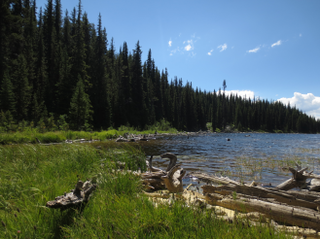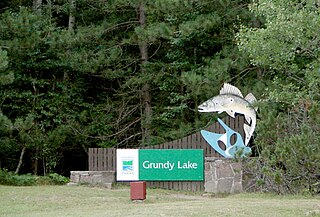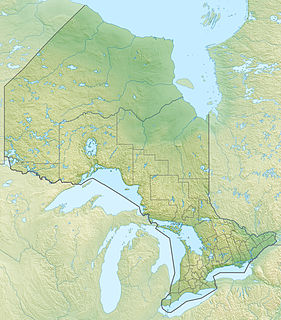
The Canadian Rocky Mountain Parks World Heritage Site is located in the Canadian Rockies. It consists of seven contiguous parks including four national parks:

The Madawaska River is a river in the Saint Lawrence River drainage basin in Ontario, Canada. The river is 230 km (143 mi) long and drains an area of 8,470 km2 (3,270 sq mi). Its name comes from an Algonquian band of the region known as "Matouweskarini", meaning "people of the shallows".

The Opeongo River is a river in the Saint Lawrence River drainage basin in Nipissing District in northeastern Ontario, Canada. The river is entirely within Algonquin Provincial Park and Opeongo River Provincial Park, except for a small portion around Victoria Lake, and is a left tributary of the Madawaska River.

Rondeau Provincial Park, located in southwestern Ontario, Canada is the second oldest provincial park having been established with an order in council on 8 September 1894. The park is located on an 8 km long crescentic sand spit extending into Lake Erie. In a 1930 soil survey most of the spit was mapped as Berrien sand, which is imperfectly drained. There are only two sand spits like this one in all of North America, one in Rondeau and one in Florida. Rondeau was established in 1894 as a response to demand for cottaging opportunities by residents of nearby Chatham. It is the second-oldest provincial park in Ontario. Until recently it was recognized as the largest tourist destination in the Municipality of Chatham-Kent. Rondeau is also home to the largest area of Carolinian forest in Canada, a long sand beach, a large marsh, approximately half of Rondeau Bay, campgrounds and a cottage community. Most of the park is natural environment; the cottage community takes up less than 1% of the park area and is practically invisible from the air. The name of the park comes from the French words "ronde eau" or "round water" which describes the shape of the harbour sheltered by the peninsula.

Frontenac Provincial Park is located near the town of Sydenham, north of the city of Kingston, Ontario, Canada. The Government of Ontario has classified Frontenac Provincial Park as a natural environment park. The park lies on the Frontenac Axis, a topographic extension of the Canadian Shield, which connects to the Adirondack Mountains, and consists of mixed forest, lakes, wetlands, and granite outcrops. Recreational opportunities include hiking, canoeing, and backcountry camping. Wilderness courses are offered to teach wilderness skills in a semi-wilderness setting.

Petrie Island is an island of parkland and recreational areas situated in the Ottawa River in the eastern part of the city of Ottawa, Ontario, Canada. The island has several nearby islands and the general collection of islands is also called Petrie Island.

Nickel Plate Provincial Park is a provincial park in British Columbia, Canada. Formerly known as Clearwater Park, it is located in the Similkameen District at the northeast corner of Nickel Plate Lake.
Summit Lake Provincial Park is a provincial park in British Columbia, Canada.
Summit Lake Provincial Park is located on Highway 6, 13 km southwest of Nakusp at the height of land between Slocan Lake and Upper Arrow Lake. The Nakusp Range of the Selkirk Mountains rises 500 metres above the lake, providing a magnificent backdrop to the many recreational opportunities provided by the park.
Park visitors can enjoy fishing for rainbow and cutthroat trout or swimming in the lake's clear, refreshing mountain water. Mountain Goats can often be viewed on rocky outcroppings and each fall a natural spectacle occurs as thousands of toads emerge from the lake and migrate to the nearby forest to hibernate for the winter.
Trembleur Lake Provincial Park is a provincial park in British Columbia, Canada.

Samuel de Champlain Provincial Park is a provincial park in Ontario, Canada.

Arrowhead Provincial Park is located north of Huntsville, Ontario, Canada, and is part of the Ontario Parks system. A portion of the shoreline of Glacial Lake Algonquin is visible in the park.
The Ontario Trails Council (OTC) is a charitable organization which promotes the management, use, preservation and development of recreational trails and trail based activity, in Ontario, Canada.

Killarney Lakelands and Headwaters Provincial Park is a provincial park in central Ontario, Canada. Located primarily within the Sudbury District with a small portion located in the Walden district of Greater Sudbury, the park was created in 2006 as an expansion of the adjacent Killarney Provincial Park.

Grundy Lake Provincial Park in Ontario, Canada, is a natural environment park established in 1959 and is part of the Ontario Parks system. The park is located near Britt, at the junction of Highway 69 and Highway 522.

Carden Alvar Provincial Park is a provincial park located in the Kawartha Lakes in Central Ontario, Canada. Alvars are globally rare ecosystems found exclusively in Northern Europe and the Great Lakes region of North America. The park is classified as a non-operating, natural environment park and was established in 2014. Natural environment parks protect outstanding landscapes, ecosystems and other elements of the province’s wilderness to provide high quality recreational and educational experiences for visitors.













